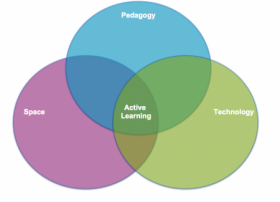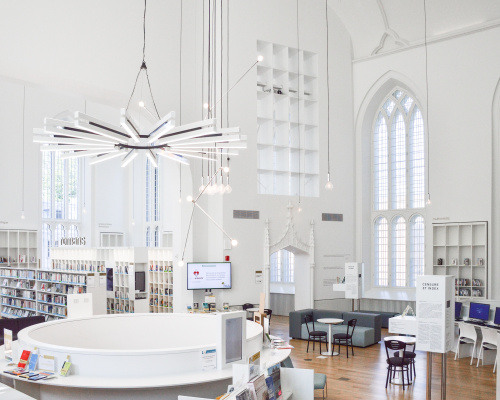Get Active: Reimagining Learning Spaces
Date
If you don’t go the gym, attend yoga classes, ride a bike, or play kickball, then what do you do on your free time? While some people are realizing the importance of moving and leading an active lifestyle, many of us are (and will always be) victims of “sitting disease.” Writing about the importance of and possibilities for active learning has made me rethink my own lifestyle and spatial choices.
As one of the co-authors of Get Active: Reimagining Active Learning Spaces, I got to move around a bit and uncover the shift for many teachers to transforming their classrooms to active learning spaces. Yes, students in these classrooms are getting up more, moving about, and sitting on yoga balls, but there’s more to it than that.
Take a look around office spaces today. Many look different from 20, 10, and even 5 years ago. Professionals have realized that space affects behavior and the work and lifestyle behaviors of employees are different now than even five years ago. Designers are happy to support the trend towards collaborative spaces, open floor plans, and a mix of sitting and standing options, for example.
But, what about schools? As with most trends, education is trailing behind. We still see desks from the 70s in today’s classroom - you know, the ones where students squeeze in (easily if they have the right body type and not so easily if they don’t); place one book on the desk because that’s all the room there is for, let alone a laptop and; shove their supplies in the wire shelf below, with the overflow on the floor. While in these desks, they often sit staring at the person’s back in front of them and cranking their head to see the teacher - you know the rest...Partially because of the space restrictions, learning is generally teacher and text-book centered, leaving disengaged and uninspired students.
Buying new furniture won’t make much of a difference if the teaching and learning is still the same. Yes, students may be more comfortable, but more important than a wobbly stool is changing teaching practices to better meet students’ needs. Nearly all teachers incorporate some aspect of student-centered learning into their instruction, such as pair shares, small group discussions, and hands-on activities. That being said, a flexible learning space can make it easier for teachers to expand their repertoire of instructional strategies to include more student-centered options. While many teaching models include collaboration, standards-based learning, formative assessment, real-world projects, problem-solving, and digital tools, active learning adds “space” to the mix: Pedagogy, Technology + Space - the sweet spot is where all three intersect.

In an active learning environment, whether it is one that includes some student-centered activities, blended or flipped learning, or full-blown project-based learning, learners need different kinds of spaces to meet their needs. Here are some kinds of spaces that support digital-age learning:
Small group areas for discussing, brainstorming, planning, and creating
- Large-group areas for whole-class instruction and presentations
- Technology-rich areas for online research, virtual communication, media production, and app development for example
- Quiet solitary spaces for individual reading, writing, and reflection
- Community accessible areas for sharing, parent meetings, and presentation
- Makerspaces where students have access to hands-on materials
Is your classroom ready for active learning? To learn more, Get Active: Reimagining Learnings Spaces for Student Success is avaialble as a free download or a book purchase at https://www.k12blueprint.com/news/get-active-reimagining-learning-spaces-student-success
The book includes activities, discussion prompts, and reflection questions to help you create active learning spaces. Use the book independently or with a group of co-workers. For example, ISTE is hosting a 6-week online Get Active book study group, which launched last week with a webinar and includes online discussion, twitter chats, and more.
I’d love to hear about your active learning spaces or if you have questions about active learning spaces.

